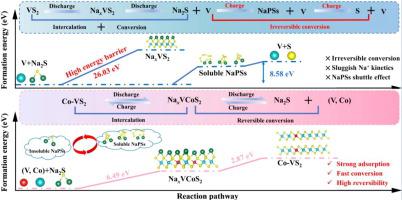当前位置:
X-MOL 学术
›
J. Energy Chem.
›
论文详情
Our official English website, www.x-mol.net, welcomes your feedback! (Note: you will need to create a separate account there.)
Unraveling high efficiency multi-step sodium storage and bidirectional redox kinetics synergy mechanism of cobalt-doping vanadium disulfide anode
Journal of Energy Chemistry ( IF 13.1 ) Pub Date : 2024-03-16 , DOI: 10.1016/j.jechem.2024.03.002 Enzhi Li , Mingshan Wang , Yuanlong Feng , Lin Yang , Qian Li , Zhenliang Yang , Junchen Chen , Bo Yu , Bingshu Guo , Zhiyuan Ma , Yun Huang , Jiangtao Liu , Xing Li
Journal of Energy Chemistry ( IF 13.1 ) Pub Date : 2024-03-16 , DOI: 10.1016/j.jechem.2024.03.002 Enzhi Li , Mingshan Wang , Yuanlong Feng , Lin Yang , Qian Li , Zhenliang Yang , Junchen Chen , Bo Yu , Bingshu Guo , Zhiyuan Ma , Yun Huang , Jiangtao Liu , Xing Li

|
Sodium-based storage devices based on conversion-type metal sulfide anodes have attracted great attention due to their multivalent ion redox reaction ability. However, they also suffer from sodium polysulfides (NaPSs) shuttling problems during the sluggish Na redox process, leading to “voltage failure” and rapid capacity decay. Herein, a metal cobalt-doping vanadium disulfide (Co-VS) is proposed to simultaneously accelerate the electrochemical reaction of VS and enhance the bidirectional redox of soluble NaPSs. It is found that the strong adsorption of NaPSs by V-Co alloy nanoparticles formed in situ during the conversion reaction of Co-VS can effectively inhibit the dissolution and shuttle of NaPSs, and thermodynamically reduce the formation energy barrier of the reaction path to effectively drive the complete conversion reaction, while the metal transition of Co elements enhances reconversion kinetics to achieve high reversibility. Moreover, Co-VS also produce abundant sulfur vacancies and unsaturated sulfur edge defects, significantly improve ionic/electron diffusion kinetics. Therefore, the Co-VS anode exhibits ultrahigh rate capability (562 mA h g at 5 A g), high initial coulombic efficiency (≈90%) and 12,000 ultralong cycle life with capacity retention of 90% in sodium-ion batteries (SIBs), as well as impressive energy/power density (118 Wh kg/31,250 W kg) and over 10,000 stable cycles in sodium-ion hybrid capacitors (SIHCs). Moreover, the pouch cell-type SIHC displays a high-energy density of 102 Wh kg and exceed 600 stable cycles. This work deepens the understanding of the electrochemical reaction mechanism of conversion-type metal sulfide anodes and provides a valuable solution to the shuttling of NaPSs in SIBs and SIHCs.
中文翻译:

揭示钴掺杂二硫化钒阳极高效多步储钠与双向氧化还原动力学协同机制
基于转换型金属硫化物阳极的钠基存储器件由于其多价离子氧化还原反应能力而引起了极大的关注。然而,它们在缓慢的Na氧化还原过程中也遇到多硫化钠(NaPS)穿梭问题,导致“电压故障”和容量快速衰减。在此,提出了一种金属钴掺杂二硫化钒(Co-VS),以同时加速VS的电化学反应并增强可溶性NaPS的双向氧化还原。研究发现,Co-VS转化反应过程中原位形成的V-Co合金纳米颗粒对NaPSs的强吸附作用,可以有效抑制NaPSs的溶解和穿梭,热力学上降低反应路径的形成能垒,有效驱动完全的转化反应,而Co元素的金属过渡增强了再转化动力学以实现高可逆性。此外,Co-VS还产生丰富的硫空位和不饱和硫边缘缺陷,显着改善离子/电子扩散动力学。因此,Co-VS负极在钠离子电池(SIB)中表现出超高的倍率性能(562 mA h g at 5 A g)、高初始库仑效率(约90%)和12,000次超长循环寿命,容量保持率为90%。以及令人印象深刻的能量/功率密度(118 Wh kg/31,250 W kg)和钠离子混合电容器(SIHC)超过 10,000 次稳定循环。此外,软包电池型SIHC表现出102 Wh kg的高能量密度和超过600个稳定循环。这项工作加深了对转化型金属硫化物阳极电化学反应机理的理解,并为NaPSs在SIB和SIHC中的穿梭提供了有价值的解决方案。
更新日期:2024-03-16
中文翻译:

揭示钴掺杂二硫化钒阳极高效多步储钠与双向氧化还原动力学协同机制
基于转换型金属硫化物阳极的钠基存储器件由于其多价离子氧化还原反应能力而引起了极大的关注。然而,它们在缓慢的Na氧化还原过程中也遇到多硫化钠(NaPS)穿梭问题,导致“电压故障”和容量快速衰减。在此,提出了一种金属钴掺杂二硫化钒(Co-VS),以同时加速VS的电化学反应并增强可溶性NaPS的双向氧化还原。研究发现,Co-VS转化反应过程中原位形成的V-Co合金纳米颗粒对NaPSs的强吸附作用,可以有效抑制NaPSs的溶解和穿梭,热力学上降低反应路径的形成能垒,有效驱动完全的转化反应,而Co元素的金属过渡增强了再转化动力学以实现高可逆性。此外,Co-VS还产生丰富的硫空位和不饱和硫边缘缺陷,显着改善离子/电子扩散动力学。因此,Co-VS负极在钠离子电池(SIB)中表现出超高的倍率性能(562 mA h g at 5 A g)、高初始库仑效率(约90%)和12,000次超长循环寿命,容量保持率为90%。以及令人印象深刻的能量/功率密度(118 Wh kg/31,250 W kg)和钠离子混合电容器(SIHC)超过 10,000 次稳定循环。此外,软包电池型SIHC表现出102 Wh kg的高能量密度和超过600个稳定循环。这项工作加深了对转化型金属硫化物阳极电化学反应机理的理解,并为NaPSs在SIB和SIHC中的穿梭提供了有价值的解决方案。



























 京公网安备 11010802027423号
京公网安备 11010802027423号